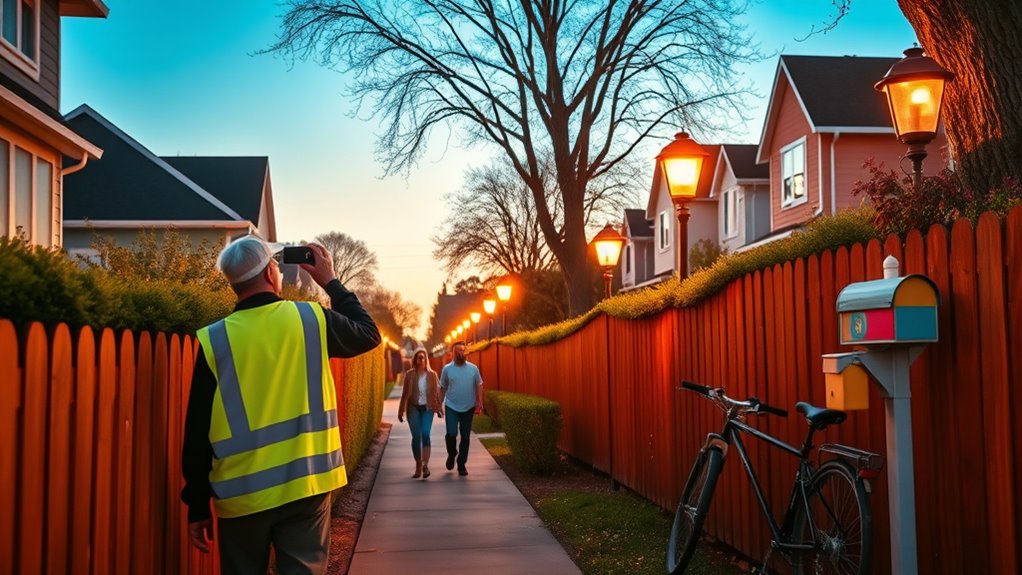To boost your neighborhood’s safety, get involved with neighbors through regular conversations, community events, and patrols. Understand local crime trends so you can focus on lighting and security measures. Secure your home with proper locks, cameras, and good outdoor lighting, especially at entrances. Start or join neighborhood watch programs and use technology like sensors and social media to stay connected. Building trust and staying informed can make a big difference—continue exploring these strategies to create a safer community.
Key Takeaways
- Foster strong community relationships through regular meetings, neighborhood events, and collaborative safety efforts.
- Promote awareness of crime trends and organize safety education workshops for residents.
- Secure homes with proper locks, security systems, and strategic outdoor lighting to deter intruders.
- Establish neighborhood watch programs, use security technology, and coordinate with authorities for proactive safety.
- Maintain open communication via social media or messaging groups to share alerts, updates, and emergency information.
Understanding Community Crime Trends
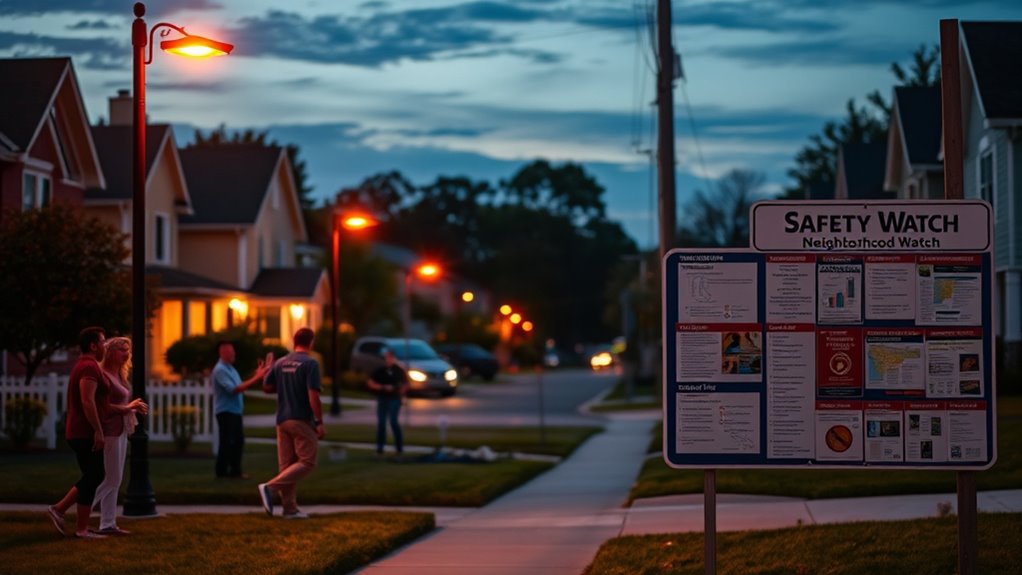
Understanding community crime trends is essential for keeping your neighborhood safe. By examining crime statistics, you gain valuable insights into the types and frequencies of crimes in your area. Trend analysis helps you identify patterns, such as peak times for burglaries or increased activity in certain blocks. This knowledge allows you to take proactive measures, like improving lighting or installing security cameras during high-risk periods. Staying informed about local crime data also enables you to respond quickly and effectively to emerging threats. Regularly reviewing crime reports and statistics helps you understand whether crime is rising or falling, guiding your safety decisions. Ultimately, understanding these trends empowers you to create a safer environment for everyone in your community.
Building Strong Neighborhood Relationships
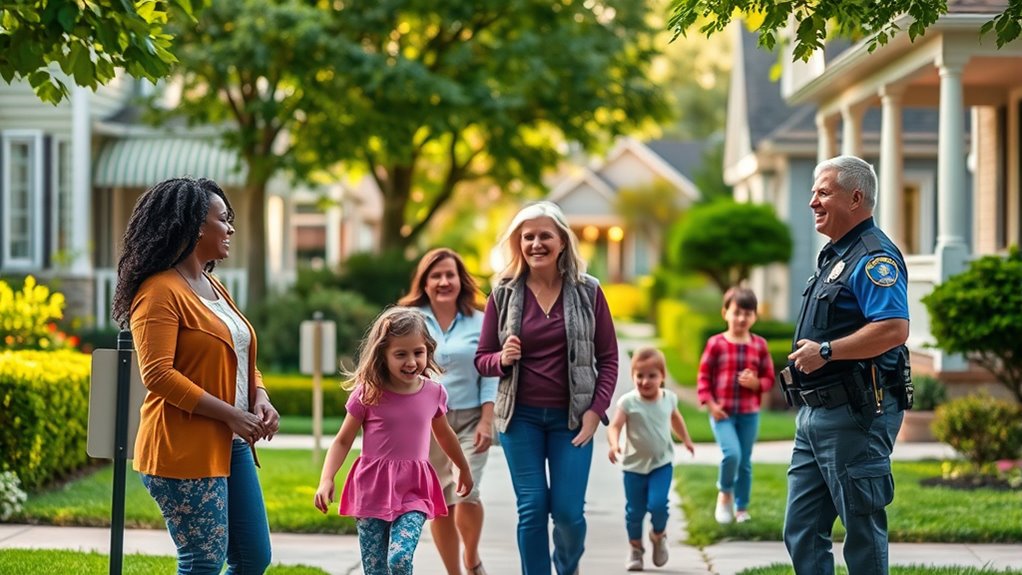
Building strong neighborhood relationships is one of the most effective ways to enhance safety and foster a sense of community. When neighbors connect through regular neighborhood events, trust and communication improve, making it easier to share safety concerns. Organize casual gatherings or block parties to encourage interaction and build rapport. Participating in community cleanup days is another great way to bond while making your area look better and safer. These activities help neighbors get to know each other, recognize unusual activity, and look out for one another. Strong relationships create a supportive environment where everyone feels responsible for safety. When you work together, it’s easier to prevent crime and respond quickly to emergencies, making your neighborhood a safer place for all residents.
Securing Your Home and Property
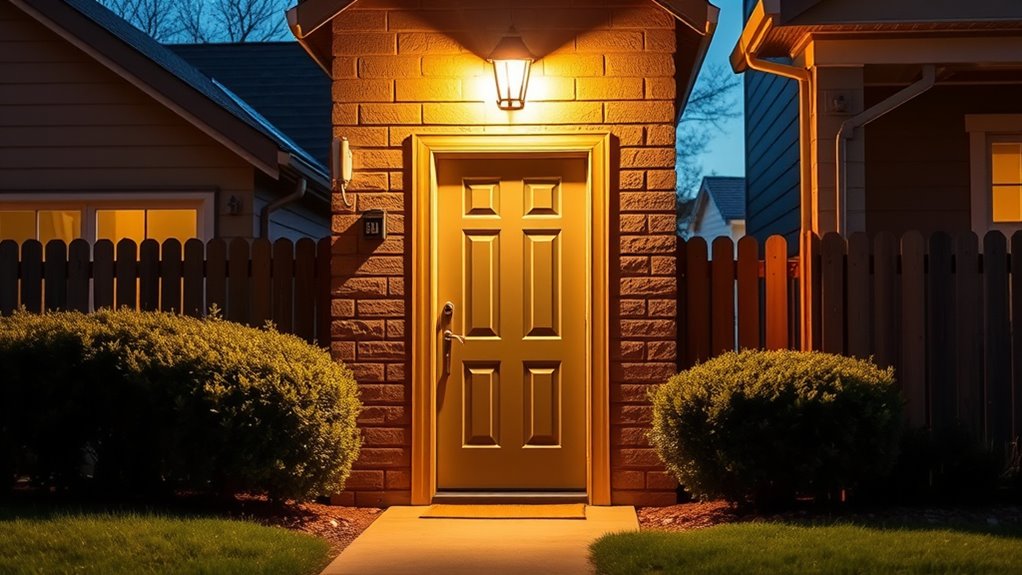
To protect your home and property, make sure you lock your doors properly every time you leave. Installing a security system can also deter intruders and alert you to any suspicious activity. Taking these simple steps can considerably improve your home’s safety.
Lock Doors Properly
Securing your home starts with locking your doors properly every time you leave or go to bed. Always double-check that all door locks are engaged, including deadbolts and handle locks. Proper key management is essential—store keys securely and avoid leaving spare keys outside. Use high-quality door locks to prevent forced entry. Remember, a lock is only effective if used consistently and correctly. Keep a record of who has keys to prevent unauthorized access. Here’s a quick reminder:
| Tip | Why it matters | Best practice |
|---|---|---|
| Lock all exterior doors | Prevents unauthorized entry | Lock doors immediately when leaving or sleeping |
| Use deadbolts | Adds extra security | Install deadbolts on all entry doors |
| Key management | Avoids lost or stolen keys | Limit key copies and keep track of keys |
| Regular lock maintenance | Ensures locks work properly | Lubricate and check locks periodically |
| Avoid hiding keys outside | Prevents easy theft | Use a trusted neighbor or lockbox |
Install Security Systems
Installing a security system enhances your home’s defenses beyond just locking the doors. It’s a crucial step in crime prevention tips, deterring potential intruders and providing peace of mind. Modern systems often include cameras, motion sensors, and alarms that alert you to suspicious activity immediately. They also contribute to emergency preparedness by ensuring help is just a button away during a break-in or other emergencies. When choosing a system, consider features like remote access and recording capabilities for added security. Properly installed security systems make your home less attractive to burglars and help you respond swiftly to threats. Overall, investing in a reliable security system is a smart move to protect your property and loved ones effectively.
Implementing Effective Lighting Strategies
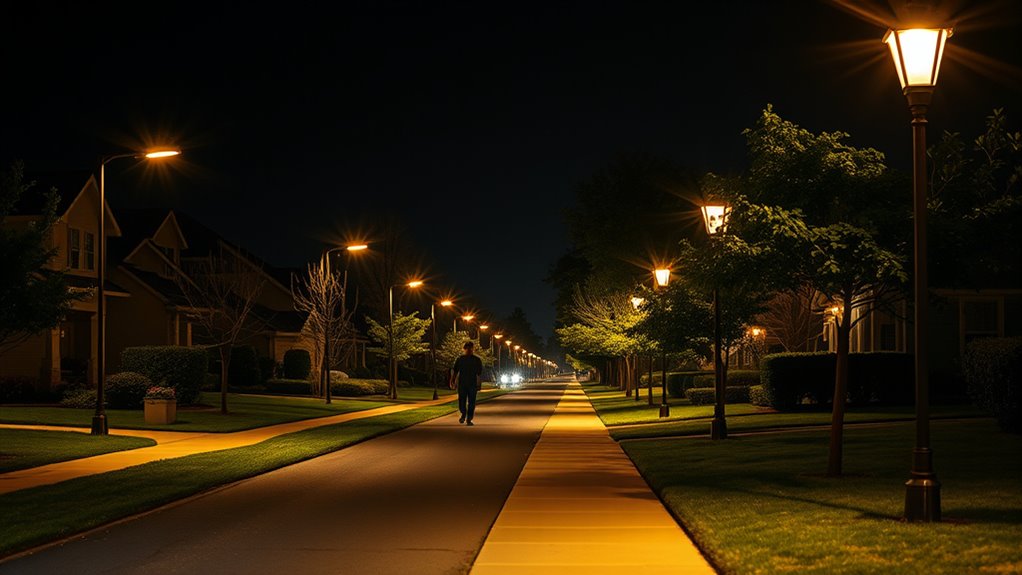
You can improve your neighborhood’s safety by carefully placing lights around walkways, entrances, and dark corners. Using motion sensors helps deter intruders by illuminating areas only when movement is detected. Effective lighting not only increases visibility but also makes your property less attractive to criminals.
Strategic Light Placement
Effective lighting is essential for deterring crime and increasing your neighborhood’s safety. Proper placement makes a big difference in visibility and security. Focus on illuminating entry points like doors, windows, and garages. Use garden lighting to highlight landscaping features and create a welcoming atmosphere. Pathway illumination guides visitors safely and prevents accidents. Avoid dark corners or secluded areas that could invite trouble.
Here’s a simple guide:
| Area | Recommended Lighting Strategy |
|---|---|
| Entry Doors | Bright, focused lighting to deter intruders |
| Pathways | Low-level pathway illumination for safety |
| Gardens | Soft garden lighting to improve visibility |
Strategic light placement guarantees your neighborhood stays safe and inviting.
Motion Sensor Use
Motion sensors enhance neighborhood safety by automatically activating lights when movement is detected, deterring potential intruders before they approach. Proper sensor placement is essential; install sensors high enough to prevent tampering and in areas with clear sightlines. Focus on key points like driveways, pathways, and dark corners where intruders might hide. Make certain your sensors have reliable motion detection capabilities that respond quickly to movement without false alarms. Adjust the sensitivity settings so lights aren’t triggered by small animals or passing cars, but still activate for human activity. Regularly check and maintain your sensors to keep them functioning properly. When used effectively, motion sensors create a well-lit environment that discourages unwanted visitors and increases your neighborhood’s safety.
Establishing Neighborhood Watch Programs
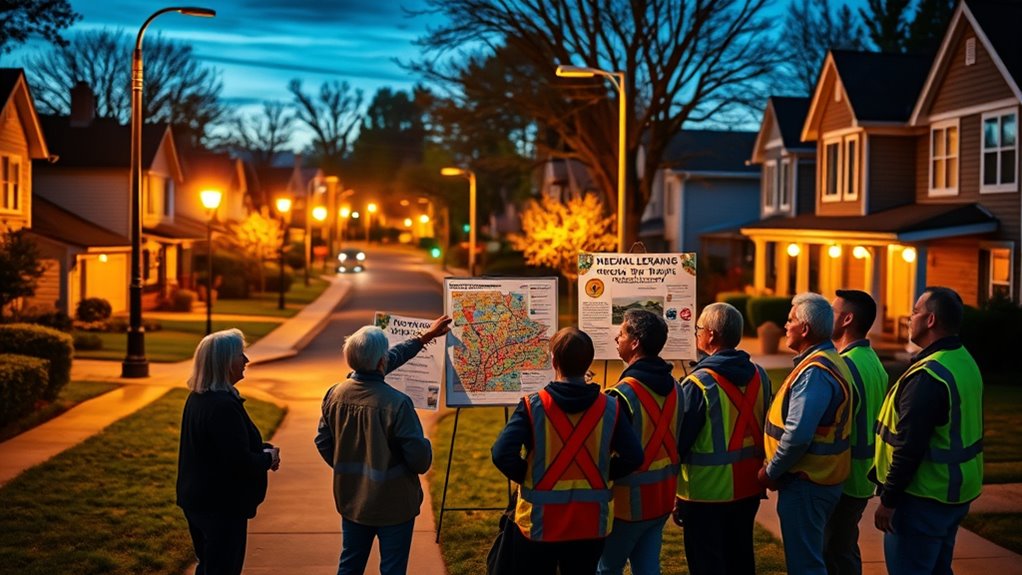
Establishing a neighborhood watch program is one of the most proactive steps residents can take to enhance safety. Your first move should be organizing a core group to plan and promote safety initiatives. Consider these key actions:
- Set up yard signage to deter potential criminals and show community unity.
- Coordinate neighborhood events to foster trust and improve communication among residents.
- Develop a reporting system for suspicious activity, encouraging everyone to stay vigilant.
Utilizing Technology for Enhanced Security
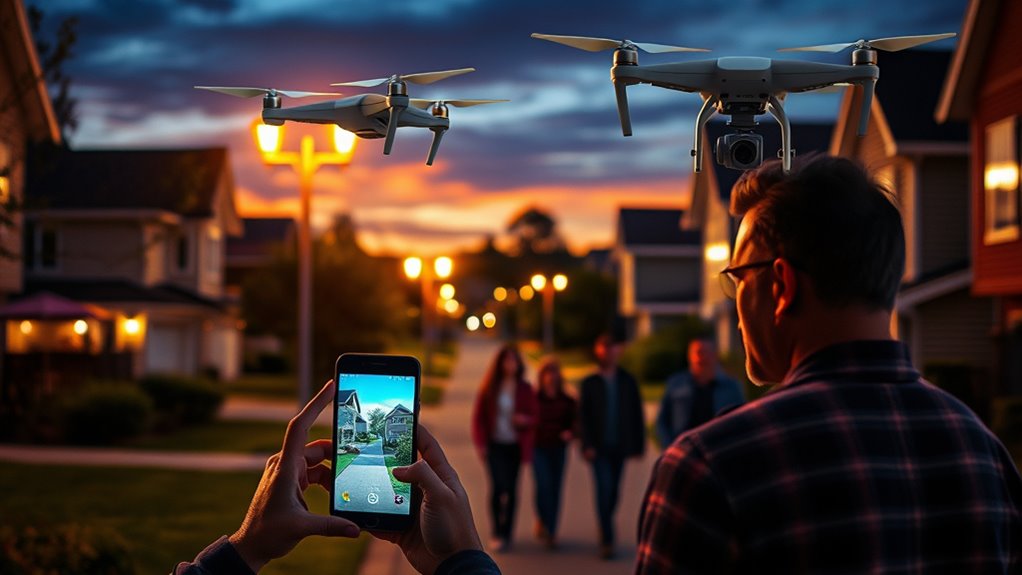
Integrating technology into your neighborhood safety efforts can substantially boost security and community awareness. Use security cameras and motion-activated lights to monitor activity and deter intruders. Stay vigilant about cybersecurity awareness by educating residents on protecting personal information online. Be cautious with social media privacy; avoid sharing sensitive details that could reveal your routines or property.
| Technology Tool | Benefit |
|---|---|
| Security Cameras | Deters crime, provides evidence |
| Social Media Privacy Settings | Protects personal info, prevents misuse |
| Community Messaging Apps | Facilitates instant communication |
| Cybersecurity Education | Reduces risks of hacking and scams |
Encouraging Active Resident Participation
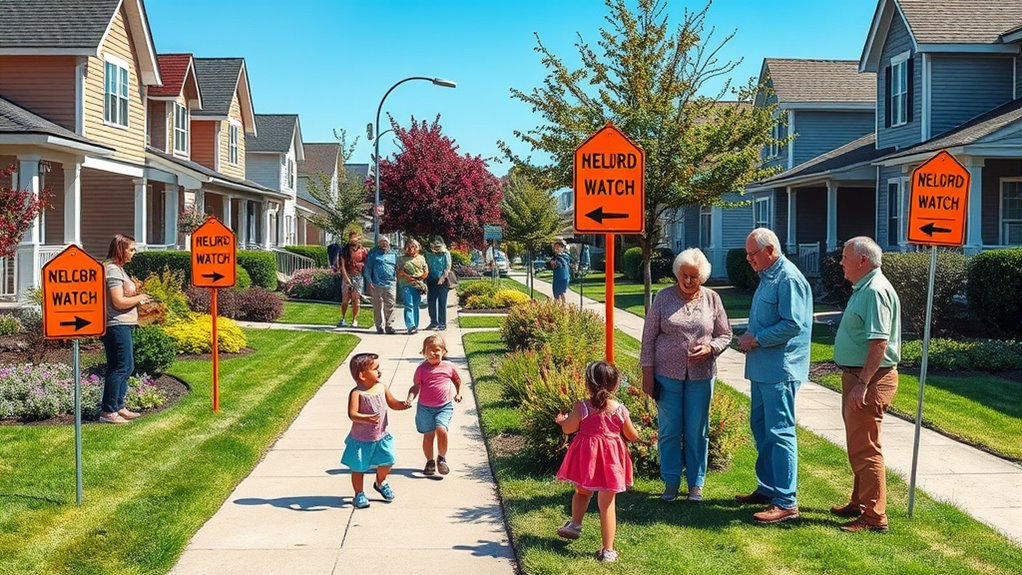
Encouraging residents to actively participate in neighborhood safety initiatives is essential for building a secure community. Your involvement strengthens the effectiveness of efforts like community patrols and neighborhood patrols. To boost participation, consider these steps:
- Organize regular community patrols where residents team up to monitor common areas.
- Create a neighborhood watch program that encourages residents to report suspicious activity.
- Host meetings to gather input and coordinate safety strategies with local authorities.
Promoting Safety Education and Awareness

Raising awareness about safety practices is essential for creating a secure neighborhood. You can do this through community outreach efforts that engage residents and promote shared responsibility. Organizing safety workshops provides a practical way to educate neighbors about crime prevention, emergency protocols, and personal safety tips. These workshops encourage participation, making everyone more aware of potential risks and how to address them. By fostering a culture of safety education, you empower residents to look out for one another and take proactive steps to protect the community. Regularly hosting these events keeps safety top of mind and builds trust among neighbors. Ultimately, informed residents are the first line of defense in maintaining a safe, resilient neighborhood.
Maintaining Consistent Communication and Updates
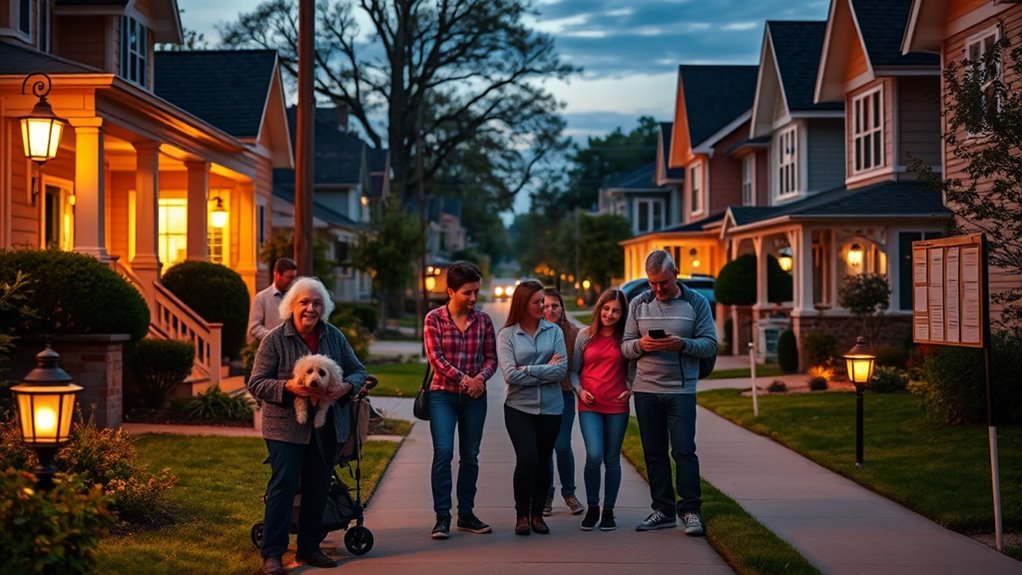
Maintaining consistent communication and updates is essential for keeping everyone informed and prepared. Clear communication guarantees your neighborhood stays proactive in emergency preparedness and traffic safety concerns. To do this effectively, consider these steps:
- Establish a neighborhood messaging system, like emails or a social media group, for quick alerts.
- Schedule regular meetings to review safety plans, share updates on traffic safety, and discuss emergency preparedness.
- Share real-time information during incidents, ensuring residents know how to respond and stay safe.
Frequently Asked Questions
How Can I Anonymously Report Suspicious Activity in My Neighborhood?
You can anonymously report suspicious activity in your neighborhood by contacting your local police department’s non-emergency line or using a dedicated online anonymous reporting tool. Joining your neighborhood watch program also encourages community collaboration and provides resources for anonymous reporting. Remember, your safety is important, so don’t hesitate to speak up through these channels—your tip could help prevent crime and keep everyone safer.
What Are the Best Ways to Secure Outdoor Valuables From Theft?
Did you know that outdoor lighting can reduce burglaries by around 20%? To secure your outdoor valuables, invest in sturdy locks and consider installing motion-activated lights. Use home security cameras to monitor your yard, and keep valuables out of sight. Proper outdoor lighting deters intruders and makes your property less attractive to thieves, ensuring your belongings stay safe and sound.
How Do I Choose the Right Security System for My Home?
To choose the right security system, consider your home’s specific needs and budget. Look for options that include home automation features, allowing you to control devices remotely for added convenience. Security cameras are essential for real-time monitoring and evidence collection. Research reputable brands, read reviews, and compare features like motion detection and app integration. Ensuring your system is easy to use and expandable will keep your home safe and give you peace of mind.
What Steps Should I Take After a Neighborhood Crime Occurs?
You jump into action immediately after a neighborhood crime, rallying your community with urgency. Contact local authorities, file detailed reports, and share essential information. Strengthen community engagement by organizing neighborhood patrols and safety meetings, turning neighbors into vigilant allies. These steps create a fortress of collective security, making your neighborhood nearly impenetrable. Your proactive approach guarantees everyone feels protected, turning a crime scene into a catalyst for stronger, safer community bonds.
How Can Residents Effectively Mediate Conflicts to Improve Safety?
You can effectively mediate conflicts by fostering community dialogue, where everyone feels heard and respected. Use conflict resolution techniques like active listening and finding common ground to address issues calmly. Encourage neighbors to discuss their concerns openly and work together on solutions. By promoting respectful communication and understanding, you help create a safer environment, strengthening neighborhood ties and preventing conflicts from escalating.
Conclusion
By staying informed, working together, and taking proactive steps, you can make your neighborhood a safer place. Remember, safety is a team effort—don’t wait for trouble to find you. When everyone pitches in, you build a strong shield that’s hard for troublemakers to breach. Keep communication open, stay vigilant, and remember that a united community is the best defense. Together, you can turn your neighborhood into a fortress of safety.

